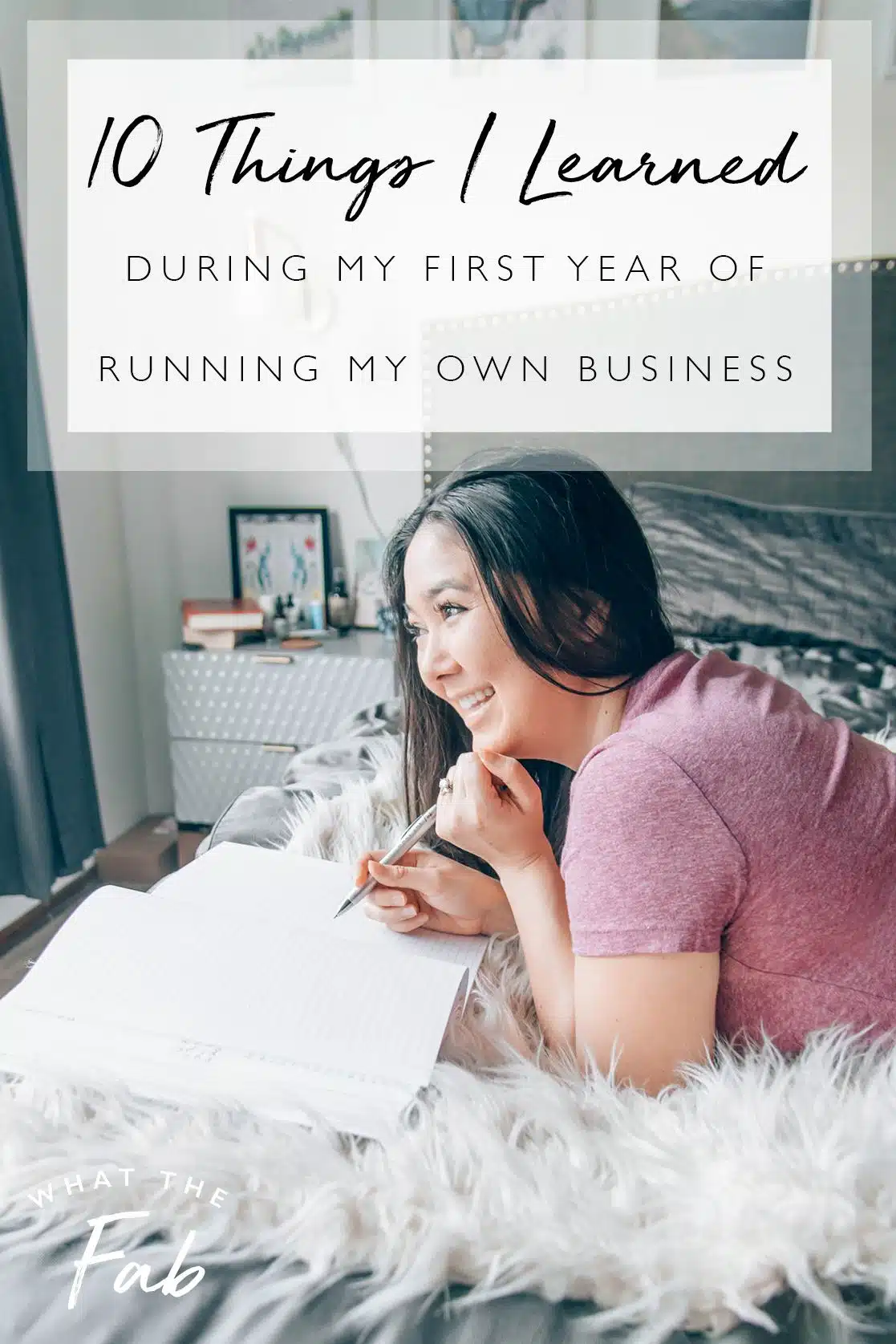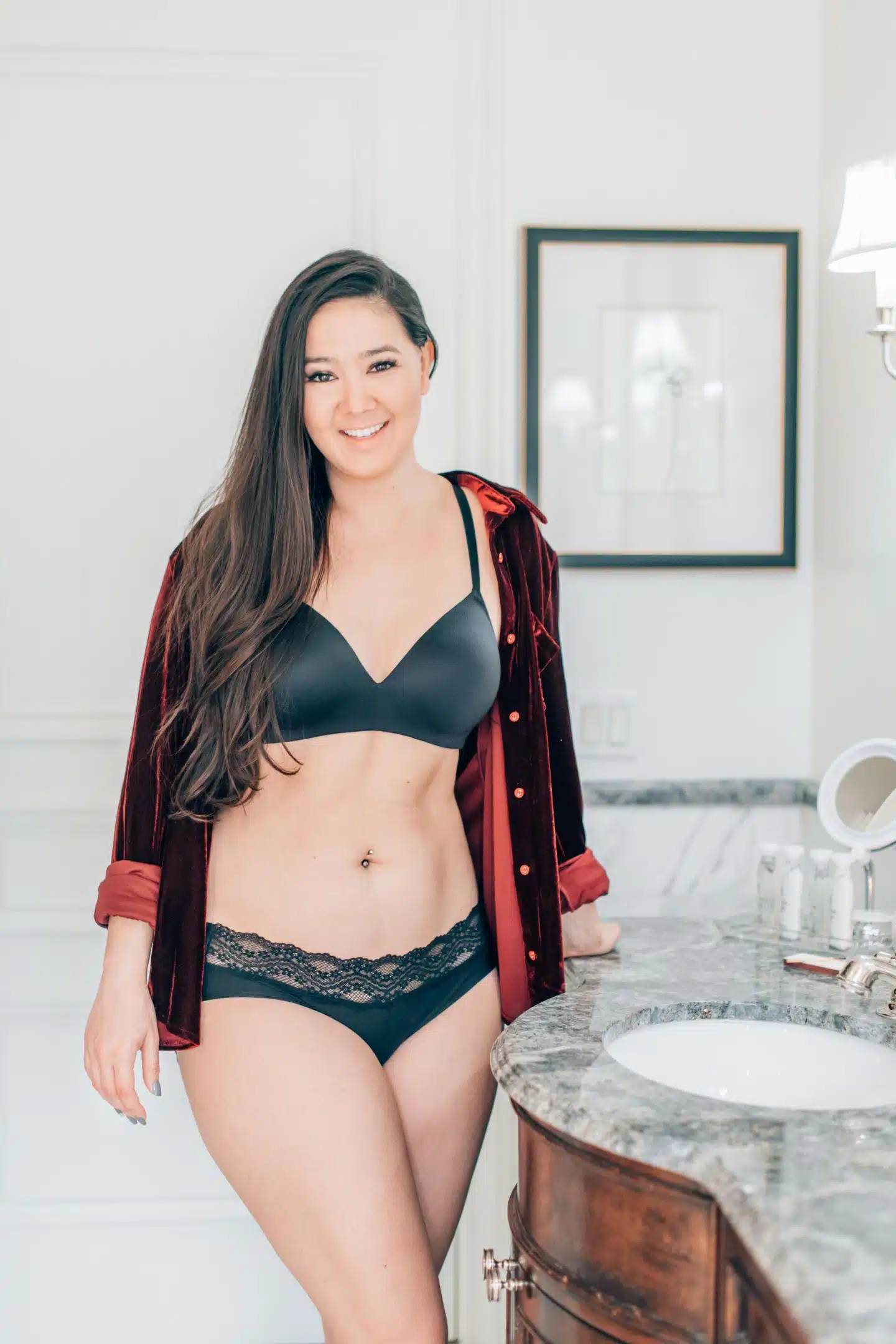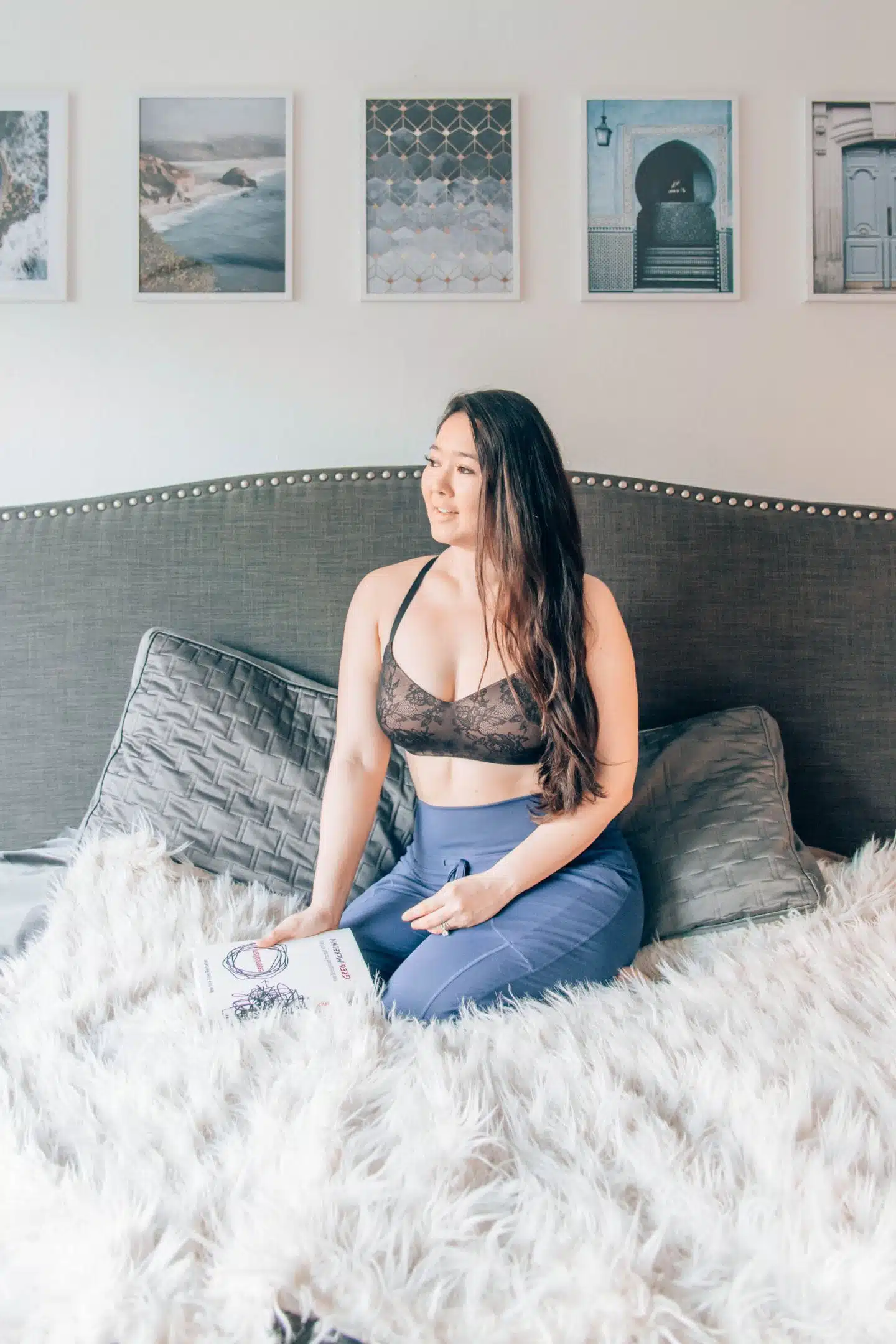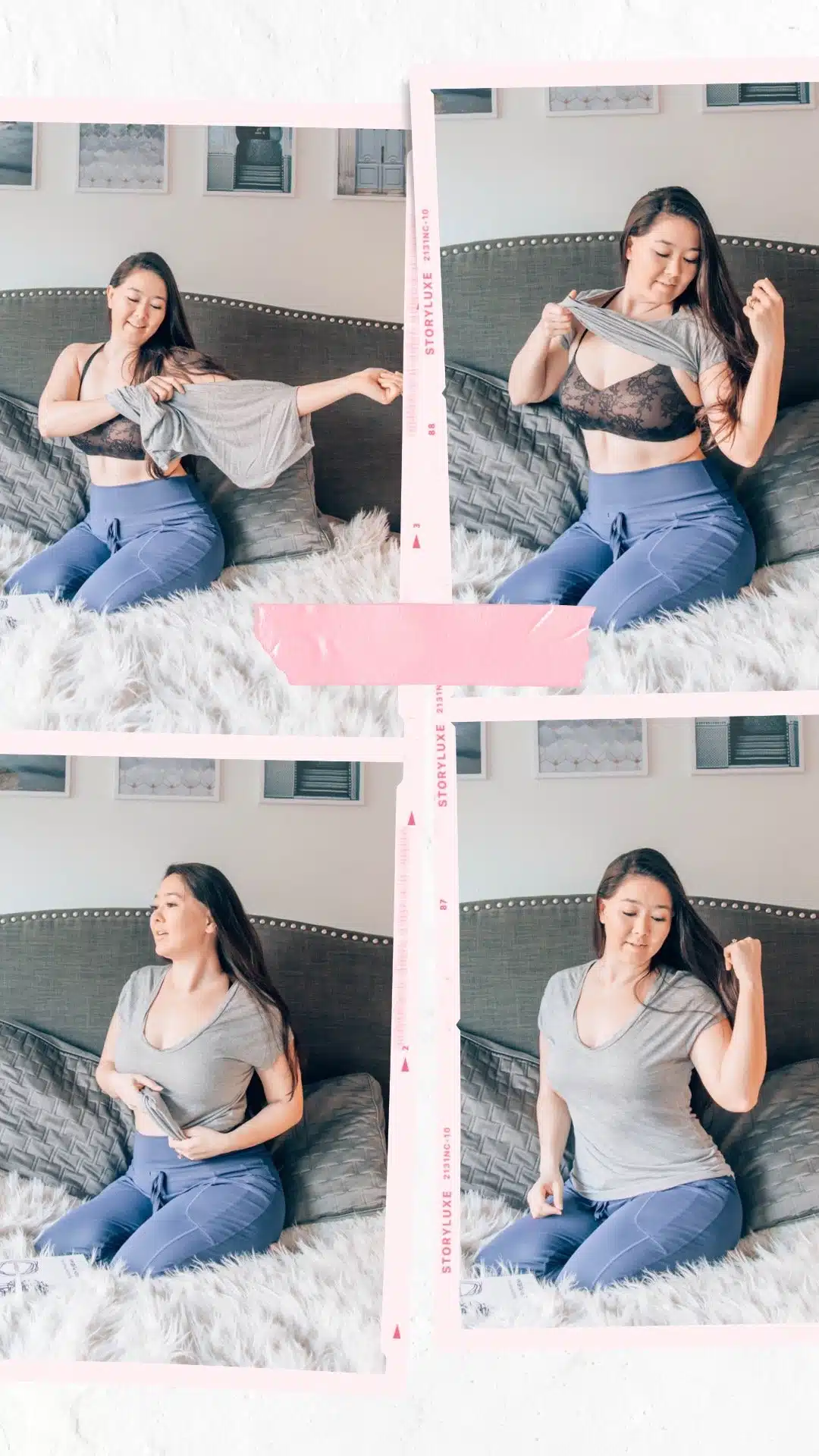
I’m so excited to be sharing this post with you today! I receive a lot of DMs and questions about how things have been going for me and my business after leaving Google—questions about how I manage my time, what I like/don’t like about working for myself, and what my day to day looks like.
The end of January marked my one year anniversary of leaving my job at Google and focusing full-time on my own business (you can read all about my decision to leave Google here). I cannot freaking believe it’s been a year! Time flies when you’re having fun—or when you’re heads-down grinding it out running your business. ?
Today I’m partnering with b.tempt’d to share with you 10 important lessons I’ve learned during my first year of running What The Fab Media full-time. There are so many things I love about b.tempt’d and how they support and empower women. First of all, head to their website or Instagram and you’re going to see women of all different sizes, shapes, and colors on their pages. #pleaseandthankyou

Secondly, I love how comfortable b.tempt’d’s bras are. I’m a big fan of their Future Foundation Wire-Free Bras, and their Future Foundation Bralette with Lace is a favorite of mine when I’m lounging or working at home. Whether I’m running to a meeting or sitting on a plane for 14 hours, the last thing I want to think about is my bra. When I wear my b.tempt’d bras, I know that I’m supported, comfortable, and looking great without any extra effort. ??

b.tempt’d asked me to come up with a word that describes me, my story, and how b.tempt’d supports me. I chose, b.bold. I even used this as my word for 2020, which was part of the Transformation Workbook and 2020 planning/goal setting I wrote about here (if you haven’t set goals for 2020, it’s not too late and these exercises will really help you!).
So let’s get into the deets, shall we? I’m sharing 10 things I learned during this first year in business for myself, and a b.bold actionable tip for each one! Because each of these lessons comes with the opportunity to b.bold, try something new, and challenge the norm. Whether you’re an entrepreneur or work for a company, I think you’ll be able to apply these to your own life and hopefully, find some value in them!
1. Rethink time management
I’ve always been pretty good at managing my time, but this past year I implemented a few new practices that have really boosted my productivity. I could write an entire post about time management/productivity (in fact I’m working on one because this is one of the main things I get asked about!), but here are a few key tips:
Ivy Lee Method: I started implementing a modified version of the Ivy Lee Method, and it’s been amazing. Instead of writing down a laundry list of to-do’s in the morning, I take time the day before to look at my calendar and my deadlines and block off time on my cal to tackle the things I want to get done. I block off enough time based on how long I think each task will take. Then the next day, I only work on that task during that specific time on my calendar. If you are honest about how long something will take you and you only focus on that one thing during that time, you will cross everything off your to-do list, whereas before I’d have 10 things on my list and only get half of them done and feel bad about it.
Time batching: Whenever possible, I work in batches instead of hopping around from task to task. Here are just a few examples of things I time batch:
- Shooting photos for several different brand campaigns in one afternoon
- Editing photos for different brand campaigns
- Working on consulting projects for my clients
- Writing and scheduling my Instagram posts for the week
- Invoicing brands from campaigns I completed over the last week
By time batching, I’m not bouncing back and forth between the many different things that are involved in running my business, which would require a lot of context switching, and I can be more efficient.
Minute-by-minute journaling: This has been huge. Before working for myself I never journaled and I thought I wouldn’t like it. But I decided to start keeping a journal when I left Google because all of a sudden I was going to have complete and total control over my own schedule, and I wanted to rethink how I structured my day.
I journal in the morning about whatever comes to mind—how I’m feeling, goals for the day, how I felt about yesterday’s work and if I felt satisfied with how I structured my day. Then, I’d keep a minute-by-minute journal for the entirety of my workday.
In this minute-by-minute journal, I’d write down the exact start and stop times for every single activity that I did. Writing a blog post, editing photos, sending invoices—everything. Did I go to post something on Instagram and ended up scrolling for 20 minutes? Gotta write that down in the journal.
The minute-by-minute journal was so helpful for two reasons. First, it helped me identify what some of my potential triggers are for losing focus and productivity. By writing them down and looking at what was a time suck, I saw that scrolling on Instagram and responding to text messages and DMs were two huge time sucks for me.
Secondly, it helped me identify which tasks I was doing that I didn’t personally need to be doing myself, and could hire help for. More on hiring help later in this post!
b.bold: Try one of these time management hacks yourself! Implement the Ivy Lee Method, try time batching, or start keeping a minute-by-minute journal.
2. Action is the antidote to fear.
When I jumped into my business full-time, there were so many things I didn’t know how to do. “Omg, how do I [insert scary-sounding and important things like file for an LLC, trademark my brand, file taxes as a blogger]?? How will I ever figure this out?” Often times, it felt overwhelming, and I felt fear creeping its way in. But as soon as I would start doing something, like researching, watching how-to videos, or filing the paperwork, things would start to come together and I’d slowly figure it out.
Same thing with running my business in general—I was so nervous and scared to leave Google, but I just plunged in and started doing. Soon, the fear washed away.
b.bold: What’s one thing you’ve been wanting to do but have been putting off because you don’t know how to, or you’re scared? Start researching that thing and then start doing.
3. You have to define what success means to you.
You have to have your own vision and clarity around what success means to you. For me, climbing the corporate ladder at Google was just not it. So while some people might think, “Why would you leave the best company in the world to work for to be a blogger?” I think, “I have complete freedom to travel for several months out of the year and work from anywhere, I make and own my business decisions 100% myself, and every achievement (and mistake) is on me.” Complete freedom and ownership are two really important things that I value in life, and having both of those feels like success to me.
b.bold: Write down five things you value in life and five things you feel you must do in this lifetime in order to feel content. Find the common themes and identify what success means to you. Then go confidently in that direction, with a clear vision.
4. Efficiency is key. Hire and ask for help.
This is true for everyone, but especially when you’re running your own business: Time is freaking money. By looking through my minute-by-minute journal, I was able to identify areas of my life where I needed help. I’ve brought on help based on this knowledge, including an assistant, a campaign manager, and an intern.
b.bold: Look at your tasks every day and see what you can get help with. Whether it’s hiring help, signing up for Amazon Fresh to deliver your groceries, using calend.ly to schedule your meetings—where can you save time?
5. Trust your gut sooner.
Ever since I was little, my mom always told me to trust my gut. There are a couple of examples I can think of over last year where I should have trusted my gut sooner. One was a brand partner who didn’t treat me with respect (and whose red flags I ignored because I really, really like their product and wanted to work with them) that I should have cut ties with earlier. Another was a toxic “friendship” that left me feeling used and my energy sucked, which I kept up for too long because I made excuses for them.
b.bold: Take a step back and really think about how decisions make you feel emotionally and physically. When you say “yes” to something (a project, happy hour with a friend, a favor for someone), how does it make you feel? If it’s positive feelings (expansiveness, contentment, happiness), then wonderful. But if it’s less than positive (anxiety, a pit in your stomach, dread), reevaluate and trust your gut!
6. The shortcut to success is 10 years of hard work.
I receive a lot of messages from people asking how they can be a full-time blogger too.
One reader told me she wanted to become a full-time travel blogger, and when I gave her advice about setting up a website and creating content for her blog she told me, “Oh, but I actually don’t like blogging!” I was v. confused. It sounds like you just want to be insta-famous then, and you’re not really interested in putting in the hard work.
I’ve also had some instances where a reader seems to get mad at me because they ask for “one thing” I did that helped propel my blog’s success, and I tell them that honestly, there was no one thing, just consistent, hard work. People don’t want to hear that—they want the magic bullet. But I started What The Fab eight years ago. This platform did not pop up overnight, and there’s still so much I want to do and areas where I want to grow. So any time I get frustrated with a new endeavor I’m trying, I remind myself that there’s no such thing as an overnight success, and to just stick with it.
b.bold: What do you want so badly that you’re willing to work hard on it every day for 10, 20, 30 years? Having clarity around your future goals and knowing that success takes time will help you get up and take one step towards your goals each day.
7. Make time for the big picture.
Last year, most of my days were spent completely in the weeds. I was doing the thing. Running the business. Shooting, editing, writing, invoicing, emailing. Rinse, repeat. By the end of 2019 I looked up and realized that while I had accomplished a lot and exceeded my financial goals and I was really proud of that, I left little to no time to myself to take a step back and think about my brand’s strategy and longterm goals.
This year, I’m setting aside several hours a week that I’m calling #BigPicEnergy for this type of thinking and work. It could be taking a course on SEO, revamping my pitching strategy for brands, or updating my media kit. The only requirement is that during that time, I work on things that are important for my brand and my long term strategy, but that don’t have a hard deadline on them so they could easily get pushed aside for brand/campaign deadlines.
b.bold: What are some long term goals you want to achieve this year and beyond? Block off time on your calendar for that #BigPicEnergy each week.
8. Saying “no” is liberating and necessary.
Over the years I’ve been practicing saying, “no.” I started saying no at Google to projects that didn’t sound interesting to me. I started saying no to unpaid blog campaigns. To my surprise, no one was upset about it, and I had more time to focus on the things I actually wanted to do.
Last year I started saying no even more. No, I’m not giving you a large discount on my sponsorship rates. No, I’m sorry but I can’t water your plants. No, I’m sorry but I can’t meet you for coffee for you to pick my brain. The more I said no, the easier it got, and the more I could focus my time and energy on the things in my life that are truly important.
b.bold: What are you currently saying yes to that you really don’t want to do? The next time something is asked of you that you truly don’t want to do, practice saying no. If you have trouble with this, I highly recommend reading Essentialism: The Disciplined Pursuit of Less.
9. Be mindful of the people you spend time with.
My time is limited, as is yours. Who you spend your very limited time with, matters. So while people might get offended when I politely decline coffee with a stranger (see #8, “Saying no”), the reality is I would rather spend that limited time catching up with my sister who I haven’t seen in a couple of months.
Not only do you need to be mindful of your time, but also your energy. When you spend time with someone, does your energy tank feel empty or full afterward?
I’ve learned to be very intentional with who I spend my time with. And when I’m with someone, be it a friend, my husband, or family, I’m fully present and I’m with them, not checking my phone, answering DMs or emails, etc.
b.bold: Don’t give just anyone your time and energy. Really be intentional with who you surround yourself with.
10. Question and challenge your assumptions
I had certain things in my mind that I thought were absolutely true about things like how I have to work and structure my day. For example, I thought that I had to get through my emails first thing in the morning so that I could have a “clear” head for the rest of the workday. This resulted in me spending hours on emails to start my day, which (guess what) just breeds more emails! It was a never-ending cycle and sometimes I would spend an entire day on emails and look up at 4:30pm only to realize I hadn’t gotten to any of my actual work.
I thought that I had to knock emails off my to-do list first thing, but about midway through last year, I decided to question and challenge that. I tried not responding to emails until the afternoon, around 2pm my time. And guess what? The world kept spinning, and my productivity skyrocketed. No, I don’t reach inbox 0 nearly as often, but I don’t have to.
b.bold: Question assumptions. What’s something about your daily life that you’ve just held to be true but never challenged? “I’m not a morning person.” “I don’t have the energy to work out after work.” Challenge one assumption and try something new. Remember, it takes 30 days to build a habit, so don’t just try it once and give up. Once you’ve given it a real shot, evaluate if the new way is working for you, or if you need to go back to your old way, or if a combo of the old and new way is the key.
Ok, that was a super meaty post but I really wanted to cover everything I’ve learned this past year in detail and hopefully provide you with some valuable takeaways! If any of this resonated with you or you’re going to try one of the b.bold tips from here, I’d love to hear from you about it!
A huge thank you to b.tempt’d for supporting me, empowering women, and sponsoring this post!


Elise Armitage is an entrepreneur and founder of What The Fab, a travel + lifestyle blog based in California. At the beginning of 2019, Elise left her corporate job at Google to chase her dreams: being an entrepreneur and helping women find fabulous in the everyday. Since then, she’s launched her SEO course Six-Figure SEO, where she teaches bloggers how to create a passive revenue stream from their website using SEO. Featured in publications like Forbes, Elle, HerMoney, and Real Simple, Elise is a firm believer that you can be of both substance and style.



